Wangari Maathai: Nobel Laureate, Environmental Icon & Women’s Rights Pioneer
The Woman Who Planted Freedom: Wangari Maathai Forest of Resistance
Nyeri, Kenya • April 1977
Rain slicked the red clay as Wangari Maathai knelt, pressing a *mubiru* seedling into the earth. Around her, women from the National Council of Women watched, skepticism in their folded arms. “How will trees feed my children?” asked a grandmother with eyes like cracked pottery. Wangari’s hands stilled on the sapling’s stem:
“This fig will hold your soil when rains come. Its leaves will shade your beans. And when you sell its fruit…” She placed a coin in the woman’s palm. “…you’ll buy medicine for that cough.”
For Wangari, trees were never just trees. They were living libraries of ancestral wisdom, women’s banks in a patriarchal society, and quiet soldiers against dictators. By her death in 2011, she’d mobilized women to plant *over 51 million trees* – and became the first African woman to win the Nobel Peace Prize. This is how a Kikuyu girl became “Mama Miti” (Mother of Trees) and taught the world that ecology is the deepest form of justice.
Roots: The Girl Who Spoke to Soil (1940s)
Young Wangarĩ Muta’s world smelled of woodsmoke and wet ferns in Ihithe village. Her grandmother’s voice wove through the dark:
“See that fig? Its roots hold underground rivers. Break it, and the springs die.”
British colonists saw forests differently – as timber piles. Wangari watched white settlers clear sacred groves for tea plantations, unmoved when landslides buried Kikuyu farms. “Their machines sounded like monsters eating the earth,” she’d recall. At 8, she secretly replanted wild orchids uprooted by soldiers – her first act of ecological resistance.
The Kennedy Airlift: An Education in Irony (1960)
At 20, Wangari boarded a propeller plane to America – part of the “Kennedy Airlift” granting Africans Western education. In Kansas, biology labs dazzled her. But in Pittsburgh, she saw rust-belt rivers choked with sludge.
“You cleaned this?” she asked locals restoring the Monongahela.
“Took 20,000 of us suing factories,” they shrugged.
The lesson seared her: Environmentalism requires democracy. Yet back in Nairobi, her doctorate in anatomy meant nothing.
- Job rejection: “Men won’t take orders from a woman professor.”
- Marital ultimatum: Husband demanded she quit activism: “Choose: family or trees.”
- Courtroom humiliation: A judge called her “too educated, too difficult, too un-Kenyan” during divorce proceedings.
Alone with three children, she sold corn by the roadside. At night, she studied satellite maps showing Kenya’s vanishing forests – 12,000 hectares lost yearly.
The Birth of Green Belt: Aprons as Armor (1977)
Drought shriveled the land in 1977. Rural women walked Wangari through their dying world:
- Rivers once deep enough to baptize in, now dust trails
- Fields stripped naked by erosion
- Children listless from malnutrition
“Why come to me?” Wangari asked.
“You’re the one who went to America,” they said. “Bring back a solution.”
She handed out seedlings of native fig and acacia.
“This is your ‘America.’ Plant it.”
The Green Belt Movement was born with radical rules:
- Women-run nurseries: “You know the land’s pain better than any expert.”
- Payment per surviving tree: 4 Kenyan shillings (enough for schoolbooks or aspirin)
- Ecological literacy: Taught under acacia trees using Kikuyu parables
Government officials mocked: “Women gardening won’t fix poverty.”
Wangari shot back: “Neither will your Swiss bank accounts.”
Uhuru Park: When Mothers Stood Against Bulldozers (1989)
President Daniel arap Moi planned a 60-story monstrosity in Nairobi’s last green lung – Uhuru Park. Wangari wrote to foreign investors:
“This tower will cast literal and metaphorical darkness over Kenya.”
Retaliation was swift:
- Police whippings: Batons split her scalp open during a park sit-in
- Media smears: State radio called her “a witch who bewitches women”
- Night terror: Thugs broke into her home screaming, “We’ll bury you where we bury dogs!”
Undeterred, she mobilized grandmothers to camp in the park. They sang Kikuyu lullabies as bulldozers revved:
“Mũkũyũ, mũkũyũ (Fig tree, fig tree)
Your roots are deeper than their greed…”
When international funders withdrew, the project died. Wangari hugged weeping women under the fig trees they’d saved. “This,” she whispered, “is what democracy smells like – wet soil and sweat.”
Sacred Groves & Cell Blocks: The Anatomy of Resistance
Karura Forest War (1999)
Moi’s cronies planned luxury homes in ancient Karura woods. Wangari led protesters into the forest.
That day:
- Youths wielding machetes slashed her cheek open
- Nuns locked arms around fig saplings
- Clerics held Bibles aloft as tear gas canisters fell
Her journal entry: “Blood on my shirt, soil in my nails. We planted 7,000 seedlings where they beat us.”
Prison Botany
Jailed for “treason,” Wangari turned her cell into a nursery:
- Smuggled seeds: Hidden in Bible pages
- “Rainwater harvesting”: Using her rice bowl
- Guerrilla planting: Tucking seedlings into cracks in the prison yard
“Every tree,” she told inmates, “is a flag of freedom no one can tear down.”
Wangari Maathai: Dancing in Banana Silk (2004)
October 8, 2004. Wangari was digging terraces when a reporter stumbled through the brush: “You’ve won the Nobel Peace Prize!”
In Oslo, she wore gowns spun from banana fiber and Luo reed necklaces. Her speech redefined peace:
“We plant because war begins where resources end. These trees are trenches dug for life.”
Back home, women danced with seedlings balanced on their heads. “They used to call us ignorant peasants,” one laughed. “Now we’re Nobel gardeners!”
The Unseen Wangari Maathai: Rituals & Vulnerabilities
- Morning practice: Sipped chai while watching geckos hunt moths – “My daily meditation on balance”
- Guilty pleasure: American crime novels (“After battling dictators, I deserve Sherlock Holmes!”)
- Secret fear: “What if we’re too late?” she whispered to her daughter during cancer treatments
- Sacred ritual: Washed her face with dew from fig leaves before protests
Her greatest grief? “That my ex-husband lived to see me win the Nobel… but never apologized.”
The Forest After the Planter (2011-Present)
Seeds Still Rising
- Wanjira Mathai (daughter) leads the movement, expanding to 30 African nations
- Urban “Seed Balls”: Schoolchildren wrap native seeds in charcoal dust, bombarding vacant lots
- Digital Forests: Apps track community tree counts – 620,000+ planted monthly
Wangari Maathai Living Syllabus
| Lesson | Real-World Ripple |
|---|---|
| “Women’s hands heal earth” | ➔ Kenya’s 2017 constitution guarantees women land ownership |
| “Plastic bags are colonialism’s ghost” | ➔ Africa’s strictest plastic ban passed in Kenya (2017) |
| “Trees are peace treaties” | ➔ “Forest Corridors” now bridge ethnic conflict zones |
The Quiet Revolution: How Wangari Maathai Legacy Grows
In a Nairobi slum, 14-year-old Aisha tends neem trees piercing concrete:
“Mama Maathai said trees breathe hope. So I breathe with them.”
In Liberia’s postwar fields, women plant “Peace Palms” using Wangari’s nursery model.
At COP28, Kenyan delegates hand fig saplings to oil executives: “Plant this instead of drilling.”
Wangari’s true monument? The ordinary courage she seeded:
- A Maasai grandmother suing miners polluting her river
- Schoolgirls demanding climate curriculum
- Prisoners growing food forests behind bars
Wangari Maathai: The Fig That Outlived the Planter
September 25, 2011. Wangari’s coffin – woven from papyrus reeds and olive branches – lowered into earth she’d fought to save. Today, a fig tree grows from her grave, its branches sheltering:
- Women signing land deeds
- Children painting seedlings on protest signs
- Activists plotting their next “guerrilla gardening” raid
Wind rustles the leaves. Some swear it whispers:
“Until the soil is free, keep planting.”
Plant Wangari Maathai Legacy:
- 🌱 Support: greenbeltmovement.org
- 📚 Read: Unbowed (her raw, poetic memoir)
- ✊ Act: Join “Seed Bomb Saturdays” in your city
“You cannot enslave a mind that knows itself.
You cannot uproot a people who plant their dreams.
We are the soil. We are the rain.
We are the forest waking.”
— Wangari Maathai’s final journal entry
David Attenborough: The Voice of Nature | Legacy, Documentaries & Climate Impact
The Man Who Whispers to the World
David Attenborough and the Art of Paying Attention

Rain hammers the tin roof of a Borneo longhouse. 1976.
Young David Attenborough sits cross-legged on rattan mats, sweat soaking his collar. An Iban tribesman passes him fermented rice wine in a coconut shell. Outside, gibbons sing the forest awake.
“They say the hornbill carries messages between worlds,” the elder murmurs, tracing bird wings in the firelight.
David leans closer. Not as a scientist. Not as a broadcaster.
As a storyteller hungry for truth.
This is who he is:
A 97-year-old man who still gasps when a damselfly lands on his notebook.
Who cries watching archival footage of glaciers he once stood upon.
Who whispers “astonishing” over a worm’s iridescent skin.
David Attenborough in the Limestone Cathedral (Leicester, 1937)
Young David’s sanctuary wasn’t his bedroom – it was a quarry.
The smell: Wet stone and crushed ferns.
The treasure: Trilobites fossilized in slate like pressed flowers.
“Split the rock,” his father taught, “and time collapses.”
One rainy Tuesday, 11-year-old David pried open a slab. Inside: the coiled shell of an ammonite – unseen for 150 million years.
He pressed his palm against its spiral.
Cold. Ancient. Alive.
At dinner, brother Richard (future actor) reenacted Shakespeare. David slid the fossil onto the tablecloth:
“This creature swam when dinosaurs were hatchlings.”
His mother sighed, “Must it live next to the gravy boat?”
The Accidental Broadcaster (BBC Studios, 1952)
Teeth. That’s why radio rejected him.
“Your sibilants whistle,” they said. “And your incisors… distract.”
Television hired him as a “trainee producer” – a role requiring zero on-camera presence.
Then: The Freddie Incident.
1953. Live broadcast. A chimpanzee named Freddie:
– Ate the chrysanthemum decorations
– Bit the director’s ankle
– Escaped into the makeup room
Panic. Static. Then… David’s voice, calm as Sunday breakfast:
“Well… Freddie seems to prefer Revlon’s ‘Cherries in the Snow’ lipstick. Can’t say I blame him.”
The switchboard lit up. “Who WAS that man?”
When Grief Became His Compass (London, 1997)
Jane’s cancer was swift. Forty-seven years of marriage ended in a hospice room smelling of lilies and antiseptic.
For months, David wandered Kew Gardens at dawn. “I’d watch spiders mend webs,” he told a friend. “Life insisting on itself.”
Then came the birds-of-paradise project. In New Guinea, he filmed a male Sicklebill – obsidian feathers catching the sun like oil slicks.
“Jane,” he breathed into his field notes.
Later, he confessed: “I needed her to see that iridescence. So I named it for her.”
The Attenborough Method: Slow Magic
1. The 90-Second Rule
The Blue Planet, 2001. A sperm whale carcass sinks through twilight.
No music. No narration. Just bubbles rising from bone.
“Hold it,” David insisted as producers fidgeted. “Let them feel the descent.”
Viewer mail: “I wept for a whale I never knew existed.”
2. The “Sideways Glance”
Madagascar, 2008. Crew filming lemurs.
David’s head swivels. “Look! The chameleon!”
A lizard’s tongue snaps a moth mid-air.
Director: “But David, we’re on lemurs–”
“THIS is the story,” he whispers. “Precision. Hunger. Grace.”
3. The Hummingbird Epiphany
His 90th birthday present to himself? High-speed cameras.
“Watch!” He grabs your sleeve like an excited boy. “Their wings draw infinity symbols in the air. Infinity!”
Kitchen Table Wisdom (David Attenborough Home, Richmond, 2023)
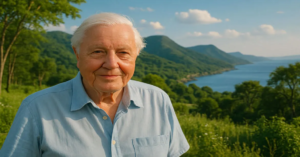
Morning ritual:
1. Feeds robins (“Robert” and “Roberta”)
2. Drinks Assam tea from a chipped “World’s Greatest Grandpa” mug
3. Reads Journal of Myrmecology (ant studies)
His confession:
“I talk to earthworms while gardening. Apologize when moving them.”
On modern nature films:
“Too much *dun-dun-DUN!* music. As if a wren building a nest is a car chase.”
The Day He Changed His Mind (Galápagos, 2005)
For decades, he avoided activism. “Not the BBC’s role.”
Then he met Lonesome George – last Pinta Island tortoise.
The creature’s eyes held millennia of solitude.
“Like staring into a dying galaxy,” David murmured.
That night, he wrote in his journal:
“We broke the world.
Now we must mend it.”
His next film: Climate Change – The Facts. Unflinching. Urgent.
Colleagues worried: “You’ll lose audiences.”
He gained 500 million viewers.
Small Moments That Moved Mountains
The Plastic Straw Revolt
After Blue Planet II showed albatrosses feeding plastic to chicks:
– A 9-year-old girl confronted her MP: “Sir David says stop!”
– Starbucks banned plastic straws within 18 months.
The Letter to Maya
2019. A child’s crayon drawing: orangutans crying over chopped trees.
His reply:
“Dearest Maya,
Tell your class this: When you breathe in, thank a tree.
When you drink, thank a cloud.
You belong to them as they belong to you.
– David”
Maya’s current project: 12,000 kids planting Indonesian rainforest.
Vulnerabilities: The Unedited Takes
- Imposter Syndrome: “I never studied biology! Just… looked.”
- Guilt: “My early films showed ‘untouched’ wilderness. But we’d already broken it.”
- Fear: “Will wonder be enough to save us?”
His coping mechanism? Naming things.
– A three-legged fox in his garden: “Hopkins”
– A star-nosed mole in Planet Earth II: “Sir Digby”
“If you name them,” he says, “you can’t ignore their fate.”
At 97: Still Curious
Glastonbury Festival, 2023
He crowd-surfed (in a wheelchair). Got a temporary tattoo: † for extinct species.
“Best mosh pit ever!” he beamed.
Papua New Guinea, 2024
Filming tree kangaroos. Heatstroke hit. Crew begged him to rest.
“Nonsense!” He sipped water, adjusted his hat. “That joey hasn’t learned to jump yet. I want to see her try.”
Why We Still Listen
“He doesn’t perform awe,” says director Sara Ford. “He is awe.”
His secret? Treating viewers as co-discoverers, not students.
– When he whispers “Shh… watch this,” 500 million hearts still.
– When he murmurs “We have a problem,” schools change curricula.
“We’re not saving ‘the planet,’” he insists. “We’re saving our home. Our only shot at wonder.”
David Attenborough Last Frame: The Garden Bench
Richmond, twilight.
David watches a thrush crack a snail on a stone.
“Clever girl,” he murmurs.
A neighbour calls over the fence: “Everything alright, Sir David?”
He smiles. “Everything’s astonishing.”
Above him, Venus pulses in a lavender sky.
The camera holds.
The thrush sings.
The world breathes.
“People protect what they love.
They love what they understand.
They understand what they’re taught to see.”
– Attenborough’s Unwritten Law
Jane Goodall in Gombe: A Vision of Hope
The Girl Who Listened to Earthworms
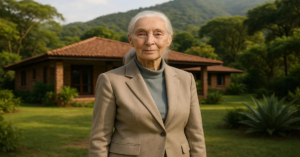
Rain drummed a secret rhythm on the tin roof of the henhouse. Four-year-old Jane Goodall pressed her palms into the cool, damp earth, holding her breath as straw pricked her knees. The speckled hen clucked nervously. “Just one more minute,” Jane willed silently, her small body coiled in anticipation. When the egg finally dropped into the nest, she scrambled home, cradling the warm treasure. Mud streaked her dress like war paint. Straw clung to her curls. Her mother Vanne didn’t scold. She knelt, brushing dirt from Jane’s cheek. “How did you wait so long, my darling?” she whispered.
That moment became Jane’s soul-deep compass:
- Patience: Learning stillness as the wary hen returned.
- Curiosity: Sketching earthworms in rain-soaked notebooks as bombs fell on wartime Bournemouth.
- Empathy: Vanne’s quiet nod when Jane declared, “Animals have feelings, Mummy. Like us.”
Africa Called. Jane Goodall Answered with a Typewriter and a Dream.
At 23, Jane stacked plates at a seaside hotel, saving shillings in a jam jar labeled “AFRICA.” When friends asked, “Why risk lions and malaria alone?” she’d grin: “Because Tarzan married the wrong Jane!” On the creaking boat to Kenya, she typed letters for Louis Leakey—a fossil hunter with eyes like flint. He noticed her during tea breaks, tracking vervet monkeys through the acacia trees. “Their fingers… like tiny humans,” she murmured, lost in wonder. Leakey saw what no university could teach: a heart that beat in sync with wild things.
Gombe: Where the Forest Whispered Its Secrets
July 1960. Tanzania’s Lake Tanganyika.
Heat hung thick as wet wool. Mosquitoes whined in Jane’s ears as she climbed razor-edged ravines. For months, chimps melted into green shadows at her approach. Blisters split her boots. Loneliness ached like hunger. Then—David Greybeard.
An elder chimp with a frosted muzzle and eyes that held ancient knowing. He let her sit ten paces away. Then five. One misty morning, he did the impossible:
- Snapped a twig from a vine.
- Peeled the leaves with surgeon’s precision.
- Dipped it into a termite mound, fishing out wriggling insects.
“They’re making tools,” Jane breathed, ink smearing her trembling notes. When she wired Leakey, laboratories erupted. “Now we must redefine ‘man,’” he wrote back, shattering human exceptionalism forever.
But Jane saw deeper truths:
- Flo, her chapped hands cradling infant Flint like precious china.
- Fifi, stealing her brother’s fruit with a mischievous hoot.
- Grief when Flint refused to leave Flo’s corpse—curled beside her for weeks, hollow-eyed, until he too stopped breathing.
“They’re persons,” Jane insisted. Cambridge dons scoffed into their sherry: “Anthropomorphic drivel!” She met their stares, voice steel: “Would you deny grief to a dog at its master’s grave?”
Jane Goodall the Forest Screamed Silence
Years later, Jane clutched a plane’s cold window. Below—bald hills gashed with red clay. Trees ripped out like rotten teeth. Chimps huddled in emerald fragments. “Like watching my children buried alive,” she’d say later, tears raw in her throat. The scientist laid down her binoculars. The warrior rose.
Jane Goodall Weapon? Relentless Hope.
1. Jane Goodall Healing Hands, Land
In Ugandan villages, Jane sat on dirt floors, sipping bitter banana beer. She listened:
- “We cut trees because the soil bleeds dust,” farmers confessed.
- “No clean water. Our babies die,” mothers whispered.
Her team answered with hands, not handouts:
- Beehives → Golden honey for market → Logging axes stilled.
- Village nurseries → 3 million trees clawing back the hills → Chimps reclaiming stolen corridors.
“Save the forests?” Jane mused. “First, you must save the people.”
2. The Orphans Who Stole Jane Goodall Heart
At Tchimpounga Sanctuary, infant chimps arrived wrapped in rags—eyes vacant, fingers clutching air where mothers should be. Jane’s team:
- Rocked them through nightmares, humming lullabies.
- Guided their hands around mangoes, sticky juice on fur.
- Built forest-islands where orphans forged new families.
A caretaker wiped sweat from her brow: “Rescue isn’t pity. It’s saying, ‘Your life matters.’”
3. The Kids Who Refused to Wait
1991. Tanzanian teens stormed Jane’s tent, plastic bags crunching underfoot: “Our beach chokes! What can we do?”
That spark became Roots & Shoots—now 150,000 fists of change worldwide:
- A Tokyo boy’s crayon petition → Supermarkets banned plastic.
- Kenyan girls → Planted 10,000 mangroves, roots knitting eroding shores.
“Children don’t see walls,” Jane laughed. “They see ladders.”
Jane Goodall Behind the Legend: Love, Loss, and Unbroken Spirit
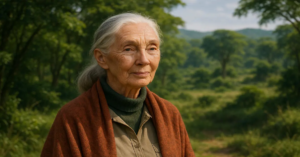
- Love: Her husband Derek died of cancer after five radiant years. She grieved in Gombe’s embrace. “The chimps knew,” she recalled. “Fifi groomed my hair so gently—like I was her own.”
- Magic: At 91, she still opens talks with a guttural “Wooooah!”—Flo’s greeting call. Audiences gasp. “That means ‘I see your soul!’”
- Faith: When climate despair loomed, she’d point to a sidewalk crack: “See? A dandelion shattering concrete. Be that defiant yellow.”
Why Her Story Still Grows
“You sip morning coffee. Was it harvested by enslaved hands? Or fair-trade farmers sending kids to school? That choice echoes. Every. Single. Dawn.”
Jane still travels 300 days a year. Her uniform tells her story:
- Blazer pocket: Jubilee, her threadbare childhood chimp.
- Shoulder bag: Crayon-smeared letters from Roots & Shoots kids.
- Voice: Feather-soft, yet it shakes auditoriums.
Her living legacy?
| Not just 340,000 saved forest acres breathing again. |
| Not just 200 rescued chimps learning to trust. |
| It’s the spark she ignites: |
| The ex-poacher tending organic tea fields, whispering “Jane believed in me.” |
| You, reading this, pausing your scroll—“What’s my dandelion move today?” |
Last Light:
At dinner once, I dared ask: “What’s the bravest thing you’ve done?”
She set down her tea. “Believing that one woman—a secretary, a dreamer, a nobody—could rewrite humanity’s place in nature’s story. And then…” Her eyes crinkled. “Doing it anyway.“
Rachel Carson’s Silent Spring Legacy: How One Woman Sparked the Modern Environmental Movement
The Whisper That Awakened the World: Rachel Carson Quiet Revolution
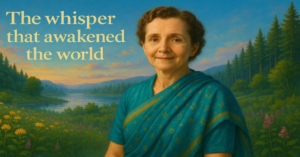
Rachel Carson Ladybug and the Lightning Rod
The year is 1917. Spring Creek, Pennsylvania. A freckled 10-year-old Rachel Carson kneels in damp soil, her braids brushing the earth as she traces a ladybug’s journey across a milkweed leaf. Her mother Maria’s voice, soft as rustling sedge grass, whispers: “Watch how she moves—see the purpose in her journey? Every creature has its epic.”
In that moment, the child who would later ignite an environmental revolution learned her first law of ecology: Attention is reverence.On their 65-acre farm without electricity or plumbing, Maria transformed poverty into pedagogy:
-
They charted bird migrations like naval expeditions
-
Observed spiderwebs as “silken cathedrals”
-
Deciphered owl calls into a “nocturnal language”
“I was happiest with wild birds and creatures as companions,” Carson later wrote. This childhood of radical noticing became her superpower—the ability to see interconnections where others saw only resources.
By age 10, she’d published in St. Nicholas Magazine. At Pennsylvania College for Women, a biology class with Professor Mary Skinker ignited her dual vision: Science as truth-teller, writing as translator. She abandoned her English major, later noting: “I couldn’t separate the beauty of nature from its mechanics. The poetry was in the facts.”
🌊 Rachel Carson Sea’s Scribe: Where Science Wore Poetry
1932: Carson stands before the all-male hiring board at the U.S. Bureau of Fisheries…
At 25, armed with a master’s in zoology from Johns Hopkins, she’s applying to write radio scripts—the only position open to women. Her examination essay on marine life stuns them with lyrical precision. She’s hired as the second female professional in agency history. When it finally printed—days before Pearl Harbor—it vanished without notice. Carson bought six copies herself to keep it in print.
Then came the miracle.
June 1951: The Sea Around Us publishes. Within weeks, it hits #1. For 86 consecutive weeks, Carson’s oceanic odyssey dominates bestseller lists—outselling Hemingway and the Bible. The New Yorker serializes it; RKO Pictures adapts it for film; she wins the National Book Award.
“To stand at the edge of the sea is to know eternity.” — The Edge of the Sea (1955)
Rachel Carson sea trilogy fused taxonomic precision with spiritual awe:
| Book | Scientific Breakthrough | Lyrical Signature |
|---|---|---|
| Under the Sea Wind | First “biography” of non-human species | “The mackerel moved like liquid metal through the deep” |
| The Sea Around Us | Revealed continental drift theory to the public | “We carry oceans in our blood like a memory of home” |
| The Edge of the Sea | Cataloged 300+ Atlantic intertidal species | “The hermit crab carries its homelessness like a poem” |
☠️ The Poisoned Spring: A Dying Woman’s War on “Biocides”
January 1958: A letter arrives from Olga Owens Huckins: “After the DDT planes came, robins convulsed on our lawn. The marsh has gone silent.” Carson initially hesitated—she was battling breast cancer, caring for her orphaned 5-year-old grandnephew Roger, and nursing her 89-year-old dying mother. Then she visited the irradiated marshes.
What she witnessed became ecological horror:
*In Illinois: Earthworms absorbed DDT, poisoning robins mid-song
*In Alabama: Fish floated belly-up in chemical-slicked streams
*On Long Island: Children developed radiation-like burns after spraying
Her research uncovered darker truths:
*DDT manufacturers knew it caused liver tumors since 1946
*Workers at Montrose Chemical wore gas masks while filling spray tanks
*USDA officials received kickbacks from chemical companies
For four years, while undergoing radical mastectomies and radiation, Carson compiled evidence. Her “poison book” grew into 1,200 pages with 55 pages of citations. She called pesticides “biocides”—life-destroyers.
💣 Rachel Carson: “Hysterical Spinster” vs. Unshakeable Truth
| Attacker | Strategy | Quote |
|---|---|---|
| Monsanto | Published “The Desolate Year” parody | “Without pesticides, locusts devour America!” |
| Velsicol | Threatened Houghton Mifflin with lawsuit | “Her claims are scientifically baseless” |
| American Cyanamid | Funded “experts” to discredit her | “A fanatic defender of cult-nature” |
Personal attacks reached fever pitch:
-
Time Magazine: Called her “a hysterical spinster obsessed with cats”
-
Former USDA Secretary: “She’s probably a communist”
-
Oklahoma Senator: Later blocked her centennial tribute as “junk science”
The most insidious attacks weaponized her identity: “Of course she hates technology—no husband or children to protect!”
April 3, 1963: Carson walks into the Senate hearing room. Bald from chemo, her wig slightly askew, she takes the stand. When chemical lobbyists interrupt, Senator Ribicoff silences them: “Let the lady speak. She earned it.”
Her testimony—delivered in a voice as calm as still water—changed history:
“We spray poisons on our food as casually as seasoning salt. These chemicals now cycle through our streams, soil, and children’s bones. This isn’t just about dead birds—it’s about the right to be safe in our own world.”
CBS aired “The Silent Spring of Rachel Carson” to 15 million viewers. President Kennedy ordered his Science Advisory Committee to investigate. Their verdict: Carson was right on every count.
⚖️ The Ripple Effect: Rachel Carson Legacy in Laws and Wings
| Year | Landmark Victory | Direct Impact |
|---|---|---|
| 1970 | EPA established; First Earth Day | 20 million marched—largest U.S. protest ever |
| 1972 | U.S. bans DDT | Bald eagle rebounds from 417 to 11,040 pairs |
| 1973 | Endangered Species Act | Saves 99% of listed species from extinction |
| 1996 | Food Quality Protection Act | Requires pesticide testing for child safety |
🔍 The Unfinished War: Carson’s Warning in the Age of Neonics
| Modern “Biocide” | Carson Connection | Current Crisis |
|---|---|---|
| Neonicotinoids | 10,000x more toxic than DDT to bees | 90% decline in U.S. monarch butterflies since 1990 |
| Glyphosate | Found in 80% of U.S. urine samples | 98% decline in frog populations in sprayed areas |
| PFAS | “Forever chemicals” in 97% of American blood | Linked to infertility and immune damage |
🌍 Why Rachel Carson Whisper Still Thunders
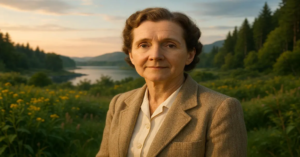
🕊️ The Philosopher of Interbeing
- Against anthropocentrism: “Why should we value a warbler less than a warehouse?”
- For kinship: “The more clearly we focus our attention on the wonders of the universe, the less taste we shall have for destruction.”
- Precursor to systems thinking: Her food chain diagrams revealed ecology as neural network
💡 The Quiet Leadership Manifesto
| Trait | Her Example | Modern Parallel |
|---|---|---|
| Introverted Impact | Worked from Maine cottage, not D.C. podiums | Greta Thunberg’s solitary school strike |
| Radical Care | Wrote Silent Spring while adopting a child and nursing her dying mother | Vanessa Nakate uplifting African climate voices |
| Love as Fuel | 900 letters to Dorothy Freeman: “The tide pools restore me” | Robin Wall Kimmerer braiding sweetgrass wisdom |
🕯️ The Unsilenced Spring: Our Turn at the Tipping Point
Spring 1964: Carson lies dying as migrating warblers return to Maine. Too weak to lift binoculars, she whispers to Dorothy: “What I ache for is to last long enough to… see the spring.”
Sixty years later, her ache becomes our imperative.
Carson’s Armory for the 21st Century
Her life bequeaths three weapons:
- WONDER AS RESISTANCE
That child tracing ladybugs became the woman who felled chemical Goliaths. Reclaim:
* Bio-blitzing: Map urban biodiversity
* Phenology journals: Track climate shifts through bloom times
*Toxic tours: Document pollution hotspots
2.PRECISION AS POWER
She destroyed DDT with 57 pages of citations. Today’s toolkit:
*EPD Explorer: Track corporate emissions
*Toxics Release Inventory: Map local polluters
*Community air monitoring
3.THE UNYIELDING “I”
One dying woman faced the Senate. Your voice is a trench.
*Sue: Join youth climate lawsuits
*Divest: Move funds from fossil banks
*Rewild: Convert lawns to native prairies
The Chickadee’s Charge
When you hear that high fee-bee in morning stillness, remember: Carson called it “a tiny flame of being.” Extinguish it? Or:
-
Demand EPA liberation from lobbyist capture
-
Push for the Farm System Reform Act
-
Teach children to read oak leaves as “earth’s braille”
“We stand now where two roads diverge. The other fork offers our last chance to reach a destination that assures the preservation of the earth.”
— Silent Spring
Sixty years later, her ache becomes our imperative.
The quiet revolution continues—one unsprayed garden, one policy battle, one awakened child at a time. What will you add to Rachel Carson’s unfinished spring? 🌸
Mohammad Younus and the Birth of Social Business: Redefining Capitalism for Global Impact
Muhammad Younus: Banking on the Poor – The Revolutionary Who Redefined Compassion in Capitalism

The air in Jobra village hung heavy with the scent of rotting jute and unspoken despair. It was 1974, and Bangladesh’s famine had turned rice paddies into graveyards. Mohammad Younus, then a Chittagong University economics professor with a Vanderbilt PhD, stepped out of his lecture hall into a reality his textbooks had erased. Amidst scavenging chickens and crumbling mud huts, he found Sufiya Begum: 21 years old, ribs visible through her thin sari, weaving bamboo stools for 12 hours daily. Her profit? Two cents. Trapped by a loan shark who demanded her output at a fraction of its value, Sufiya’s debt was a life sentence. As she whispered, “Even my tears are not my own,” Yunus felt the violent collapse of academic abstraction. That afternoon, he lent $27 to 42 villagers—enough to break their chains. The amount was trivial; the act was seismic. Microfinance was born not in a boardroom, but in the scorching heat of human indignity.
The Architecture of Dignity: How Grameen Bank Rewrote the Rules
Yunus’ epiphany was radical in its simplicity: “Poverty isn’t created by the poor. It’s engineered by systems that exclude them.” Traditional banks saw the destitute as “unbankable”—too risky, too ignorant. But Yunus recognized their invisible collateral: the intricate web of trust in villages where neighbors shared rice pots and childcare. His weapon against poverty? Grameen Bank (“Village Bank”), which replaced contracts with community and collateral with conscience.
Mohammad Younus: The Mechanics of Trust
- Group Lending Circles: Five women—often strangers—voluntarily linked fates. No lawyer witnessed their pact; their bond was shared vulnerability turned strength. When Rokeya’s cow died, her group repaid her loan installments for months. “Her loss was ours,” said Fatema, a co-borrower. Default rates dropped to 1.9%—lower than JPMorgan Chase’s credit cards.
- Daily Micro-Repayments: A fish-seller repaid 30 cents daily at dawn, moments before buying stock at the market. This rhythm respected the pulse of informal economies where a dollar today beats ten tomorrow.
- The Feminist Financial Revolution: After early loans to men funded cigarettes and lottery tickets, Yunus pivoted to women. Imams warned he’d “corrupt society.” His retort? “If a woman earns, she feeds the family. If a man earns, he feeds his ego.” Today, 9.3 million women borrow from Grameen. When Ayesha took her first $35 loan, she buried her face in her scarf, weeping: “Now my daughter won’t be sold as a maid.”
Mohammad Younus: The Ripple Effects of Financial Inclusion
Grameen’s true genius lay in the “Sixteen Decisions”—a borrower’s manifesto etched into village walls:
“We shall grow vegetables year-round. We shall send our children to school. We shall drink clean water. We shall refuse dowries.”
These vows became self-fulfilling prophecies. In Nilphamari district, Grameen borrowers dug 3,000 tube wells. In Satkhira, child marriage rates plummeted 74% after women withheld loans from families demanding dowries. When a cleric denounced Yunus, he disarmed him with theology: “Khadija, the Prophet’s wife, was a merchant. Denying women business is denying Islam’s heritage.”
Mohammad Younus: Scaling Dignity, Defying Skeptics
By 2006, Grameen had dispersed $5.7 billion in loans averaging $150. During Bangladesh’s 1998 floods, while corporate defaults soared, Grameen’s repayment rate held at 97.1%. The model thrived from Glasgow (where addicts became caterers) to the Bronx (where single moms launched daycare co-ops).
But Yunus’ boldest move targeted society’s “untouchables”: beggars. His Struggling Members Program gave 26,000 beggars merchandise—soap, snacks, toys—to sell while soliciting alms. Taslima, a blind widow, recalled her first sale: “A man bought biscuits from me. Then he said, ‘Sit, Auntie. Rest your feet.’ No one had called me ‘Auntie’ in 20 years.”
Mohammad Younus: The Three Zeros and Social Business
Yunus saw microfinance as merely a scalpel for capitalism’s cancerous flaws. “Our system confuses profit-maximization with human purpose,” he declared in A World of Three Zeros. His antidote? A trio of revolutions:
- Zero Poverty: “Charity is aspirin. Entrepreneurship is penicillin.”
- Zero Unemployment: “We train children to beg for jobs. Let them create jobs!”
- Zero Net Carbon: “Profit means nothing on a dead planet.”
Mohammad Younus: The Social Business Experiment
- Grameen Danone: Sold nutrient-rich “Shokti Doi” yogurt through village women. For 10-year-old Rina, battling stunting, two cups weekly added 3cm to her height in 6 months.
- Grameen Veolia: Built water plants selling 1-liter bottles for 1 cent in arsenic-contaminated villages.
- Grameen Intel: Trained 112,000 “telemedicine midwives” to reduce maternal deaths.
“Investors get their money back—and a dividend measured in lives,” Yunus explained. When a French CEO asked, “Where’s the incentive?” Yunus smiled: “Where’s yours when you kiss your child goodnight?”
The Human Spark: Mohammad Younus
Yunus’ faith in human creativity was absolute. “Every person is a bonsai entrepreneur,” he insisted. “Poverty is the pot that stunts our growth.”
The Unlikely Heirs
- Sufiya’s granddaughter, Jesmin, graduated from medical school in 2021—funded by loans her grandmother co-guaranteed.
- Alexa Roland, the McGill student who abandoned Wall Street after meeting Yunus, now runs a social business incubator in Nairobi’s Kibera slum.
- Diego Peña, a former Honduran gang member, used a $200 loan to start a bicycle repair shop. “Grameen didn’t give me money. It gave me back my name,” he says.
Mohammad Younus: The Unfinished Revolution
At 83, Yunus faces political persecution—fined for “tax evasion” many call fabricated. Yet his vision accelerates:
- Glasgow’s Grameen funds refugee-run bakeries where Syrian flatbreads sell beside Scottish scones.
- Yunus Environment Hub backs youth-led climate ventures from Dhaka (plastic roads) to Detroit (urban forests).
- McGill’s Social Business Centre incubates indigenous-owned renewable energy firms.
“They try to jail me because poverty is a $4 trillion industry,” Yunus told the UN. “But no prison is large enough to cage an idea.”
The Eternal Equation
Yunus’ legacy isn’t in the billions loaned, but in dismantling the myth of worthiness. As he told Sufiya:
“This money isn’t charity. It’s a mirror. Look—you see a woman who repays. A mother who invests. A human the world called ‘nothing,’ who will now build everything.”
In villages from Jobra to Johannesburg, that reflection still ignites revolutions. Where bankers saw deficits, Yunus saw infinity—and proved hope could be loaned, not given.
“Poverty belongs in museums. Let our grandchildren point and whisper, ‘How could they have allowed it?’ as they walk past its glass case.”
—Muhammad Yunus
Nadia Murad: Nobel Laureate, Human Rights Champion & Yazidi Genocide Survivor
The Girl Who Painted Nails and Shattered Silence: Nadia Murad War Against Forgetting
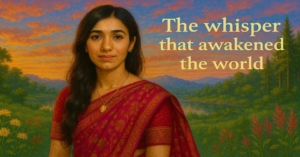
When ISIS tried to erase her people, Nadia Murad became their living memory.
Prologue: The Oven and the Ash
Kocho, Iraq – August 12, 2014
The scent of burning wheat cakes usually meant celebration in Nadia’s home. Tonight, it smelled of endings. Her mother, Shami – a woman whose hands could soothe fevered brows and knead bread into submission – fed decades of memories into the tandoor oven. Wedding portraits. Baby footprints pressed in clay. Nadia’s sixth-grade certificate.
“Why, Mama?” 21-year-old Nadia whispered.
Shami didn’t look up. “The monsters coming… they don’t get to see how much we loved.”
As flames swallowed Nadia’s childhood smile, she understood: ISIS wasn’t just coming for their bodies. They came to exterminate joy itself.
Book I: The Breaking
Chapter 1: The Day the Sky Fell
August 15, 2014 – 6:47 AM
The first motorcycle backfired. Then hundreds. Black flags swallowed the horizon. Nadia’s brother Elias shoved a wad of dinars into her waistband: “For bribes. Run if you can.”
What was lost in 3 hours:
- Her mother shot execution-style near the schoolhouse
- Six brothers marched to mass graves (“Too old for slaves, too Yazidi to live”)
- 82 Kocho elders burned alive in a granary
What was stolen:
Nadia and 6,761 Yazidi women loaded onto cattle trucks. Price tags tied to their wrists:
$25 for virgins
$15 for “used”
In the slave market of Mosul, a man with bad teeth bought her. He called it “nikah al-jihad” – marriage to holy war. She called it rape. “When he bit my shoulder, I tasted my blood and thought: This is how Yazidis die now. Not fighting. Not praying. In silence.“
Book II: The Unlocking

Chapter 2: The Door Left Open
November 2014 – Rain Season
Three months in hell. Then – divine carelessness. Her captor forgot to lock the balcony door.
The escape sequence:
- 5:32 AM: Slipped past snoring guards in socks
- 6:15 AM: Hid in a trash-filled alley as calls to prayer echoed
- 9:03 AM: Knocked on a green door – “Allah u Akbar” sticker peeling off
An elderly Sunni woman pulled her inside. “You’re the ghost girl from TV,” she whispered. For 9 days, they hid Nadia in a wardrobe smelling of mothballs and dried figs. Her saviors’ son, Mahmoud, later confessed: “We broke Takfiri law saving you. If they come… we die smiling.”
Book III: The Reckoning
Chapter 3: How Tears Became Torpedoes
Rwanga Refugee Camp – February 2015
In a shipping container smelling of rust and despair, Nadia faced Belgian journalist Stéphanie.
The Interview That Almost Didn’t Happen:
- Alias used: Basima (“smiling one”)
- First question: “What did they serve at your last birthday?”
Nadia broke: “My mother’s kleicha cookies… with date paste…”
The resulting photo – Nadia fetal on a thin mattress – went viral.
Impact: 17,000 emails to UN delegates in 72 hours.
The Reluctant Warrior’s Arsenal:
- 2016: Named first UN Goodwill Ambassador for Trafficking Survivors
- 2017: Sued ISIS financiers with Amal Clooney (“Corporate blood money built my cage”)
- 2018: Launched Nadia’s Initiative – “Not charity. Reparations.”
Table: What Survivor-Led Rebuilding Really Means
| Traditional Aid | Nadia’s Model |
|---|---|
| Foreign experts design projects | Yazidi women draft blueprints |
| Temporary shelters | Rebuilt homes with ancestral tilework |
| Trauma counseling | Farming therapy on reclaimed land |
| “Victim” narratives | Job training at women-run construction firms |
Nadia Murad: The Alchemy of Pain
Chapter 4: The Nobel and the Nail Polish
Oslo – December 10, 2018
As the Nobel medal settled around her neck, Nadia felt her mother’s phantom hand squeeze hers. Backstage, she did something unexpected: Applied ruby-red lipstick.
“Why the makeup?” a reporter asked.
“Because they tried to make me invisible,” she smiled. “Today, 800 million people see me.”
Her Secret Weapons of Resilience:
- Love: Married Abid Shamdeen in 2018. Vows: “Till justice comes.”
- Learning: Graduated from American University in 2024. Thesis: “Rape as a Weapon of Genocide: The Yazidi Case”
- Laughter: Still watches Baghdad beauty vloggers. “When I do winged eyeliner, it’s resistance.”
Nadia Murad: The Unfinished War
Nadia Murad: Ghosts in the Soil
Sinjar – Present Day
Nadia walks minefields where her brothers died. Demining teams follow her footprints.
What “Justice” Looks Like in 2024:
- Mass Graves: 87 sites excavated. 1,200 bodies identified
- ISIS Trials: 47 convictions. 18,000 perpetrators still free
- The Missing: 2,800+ women unaccounted for
Her Field Notes from Last Month:
- Water Project: Restored Kocho’s ancient karez tunnels → 3,000 families returned
- School Reopening: 76 girls enrolled – first female students since genocide
- Obstacle: Iraqi govt froze $3M in rebuilding funds
Nadia Murad: The Last Girl Manifesto
Why Nadia Murad Still Fights
At Harvard last month, a student asked: “When do you stop?”
Nadia lifted her sleeve. Showed the barcode ISIS tattooed on her wrist.
“When this number means nothing. When a Yazidi girl in Sinjar can:
– Walk to school without stepping on her grandfather’s bones
– Dream of salons or satellites without men deciding
– Be just a girl – not the ‘last’ of anything.”
Her Toolkit for Global Citizens:
- Demand Corporate Accountability: “Your pension fund invests in genocide enablers.”
- Visit Refugee Camps: “Not to volunteer. To witness.”
- Pressure Museums: “Display Yazidi artifacts ISIS tried to destroy.”
- Share Survivor Art: “Our poetry outlives their bullets.”
Nadia Murad: The Bread Oven Redemption
Kocho – March 2024
Nadia kneels where her mother burned photos. Today, she feeds oak logs into the rebuilt tandoor. Village women gather with dough shaped like:
– Doves (for murdered sons)
– Poppies (for mass graves)
– Books (for Nadia’s degree)
As the first bread emerges – golden, blistered, breathing – an elder whispers: “You didn’t just bring us home, khata. You brought our joy back.”
Nadia touches her wrist. The barcode remains. But now, flour dust settles over it like a benediction.
Where Hope Lives Now
🔗 Nadia’s Initiative – Rebuild homes with survivors
📖 The Last Girl memoir – “The book ISIS tried to prevent”
🎧 Sinjar Soundscapes – Oral histories of Yazidi elders
Final Note:
Nadia Murad didn’t just survive. She transformed genocide’s grammar – turning victims into architects, trauma into testimony, and the world’s indifference into a weapon she forged against itself. The girl who dreamed of painting nails now tattoos justice on humanity’s conscience. And her work? It’s nowhere near done.